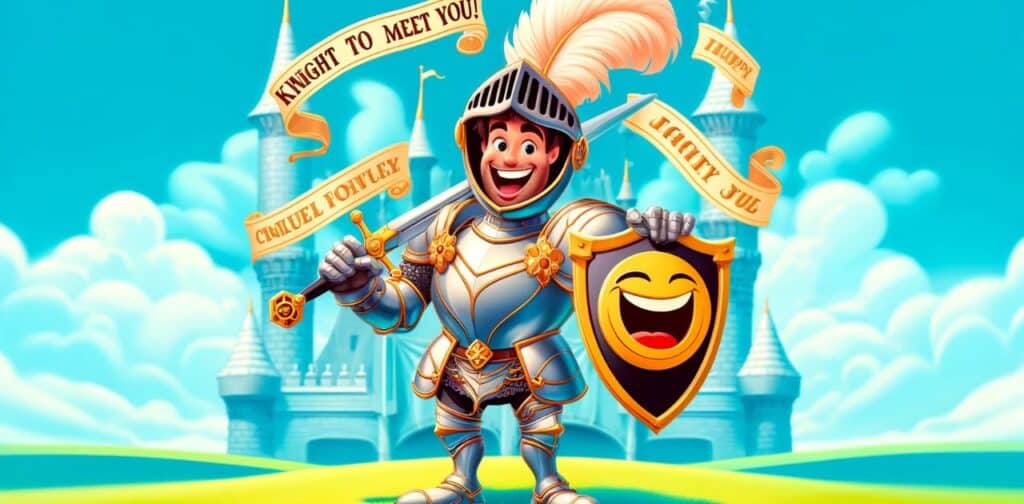Welcome to the enchanted realm where medieval valor meets modern wit! If you’ve ever envisioned knights in shining armor exchanging clever quips and playful jests, you’re in for a delightful treat. This extensive guide delves deep into the world of knight puns, from armor-plated humor to swordplay jokes, providing you with a treasure trove of laughter and medieval charm. Whether you’re a history buff, a fan of medieval humor or simply someone who enjoys a good pun, this collection of knightly wordplay will entertain and amuse.
Knight puns bring a delightful twist to medieval themes with clever wordplay. Imagine knights not only battling dragons but also delivering jokes that make everyone laugh. These puns play on words related to armor, swordplay, and chivalry, turning historical elements into hilarious humor. From Sir Render to Swordfish, each pun adds a touch of comedy to the grand tales of knights.
Jousting with Words: The Best Knightly Wordplay
In the chivalric tradition of medieval knights, humor might seem like an anachronism, but knightly wordplay brings together the grandeur of knights and the cleverness of puns. The art of crafting these jokes lies in blending historical elements with contemporary language, creating a unique and engaging form of humor.
Understanding Knightly Wordplay
Knightly wordplay revolves around the clever use of language related to medieval knights and their era. These puns often involve wordplay on terms associated with knights, such as armor, swords, and chivalry, blending historical context with modern humor. The charm of these puns lies in their ability to take familiar phrases and give them a medieval twist, creating humor that is both relatable and historically resonant.
Understanding knightly wordplay involves appreciating how medieval themes are turned into clever jokes. These puns use familiar elements from the world of knights, such as their armor, swordplay, and chivalric titles, to create humorous twists. For example, calling a knight “Sir Render” plays on the word “surrender,” while “Sir Loin” is a pun on “sirloin,” a type of steak.
Knightly wordplay is more than just amusing; it connects historical imagery with modern humor. By blending chivalry with clever word usage, these puns offer a playful way to engage with medieval lore, making the past feel both relevant and entertaining.
Examples of Top Knight Puns
Here are some of the best knightly quips that exemplify the cleverness and charm of medieval humor:
- “Why did the knight always carry a pencil? Because he wanted to draw his sword!”
- This pun cleverly plays on the dual meanings of the word “draw”: to pull out a sword and to make a drawing. It humorously suggests that a knight’s readiness to fight is complemented by his artistic skills.
- “What do you call a knight who is afraid of the dark? Sir Chicken!”
- This joke combines the traditional knight’s title “Sir” with “chicken,” a modern term for someone who is easily frightened. The result is a funny and unexpected image of a brave knight who is afraid of the dark.
- “Why did the knight always get invited to parties? Because he was a real ‘gallant’ guest!”
- The pun here uses the word “gallant,” which refers both to the knight’s chivalric qualities and to being charming or attractive. It humorously suggests that the knight’s politeness and charm make him a popular guest.
Why These Puns Work
The effectiveness of knightly wordplay stems from its clever manipulation of language and historical context. By taking familiar phrases or concepts and infusing them with medieval elements, these puns create a humorous contrast that is both engaging and amusing. The blending of historical references with modern language adds a layer of sophistication to the humor, making these puns appealing to a wide audience.
Armor-Plated Humor: Puns That Shield You with Laughter
Armor-plated humor delivers jokes so entertaining, they feel like a shield against the everyday grind. For example, a pun like “Why did the knight always carry a pencil? In case he needed to draw his sword!” uses medieval imagery to spark laughter. Similarly, a quip like “What’s a knight’s favorite part of his armor? The chest plate, because it’s always the best dressed!” adds a playful twist to historical themes.
These puns blend historical elements with clever wordplay, creating a comedic shield that brightens up any situation. By using jokes related to knights and their armor, armor-plated humor ensures that laughter is always within reach, turning mundane moments into memorable and amusing experiences.
Armor, the quintessential symbol of a knight’s protection and valor, also serves as a sturdy foundation for humor. Armor-plated humor combines medieval imagery with clever wordplay to shield you from dull moments and bring laughter.
Puns About Armor
The intricacies of knightly armor offer rich material for puns. Here are some examples that play on this theme:
- “What did the knight say when he put on his new armor? ‘This suit is knight-tacular!'”
- This pun combines “knight” with “spectacular,” humorously praising the new armor as being exceptionally impressive. It creates a playful twist on the traditional compliment.
- “Why did the knight get a job in a music store? Because he knew all about ‘armored’ notes!”
- The pun here plays on the similarity between “armor” and “armored,” suggesting that the knight’s expertise extends to musical notes. It cleverly combines medieval and musical elements.
- “Why did the knight refuse to go to the party? He couldn’t handle all the ‘plate’ talk!”
- Using “plate” to refer both to armor plates and to social conversation topics, this joke creates a humorous image of a knight avoiding social gatherings due to the conversation content.
Play on Medieval Weaponry
Play on medieval weaponry transforms historical arms into humorous quips. For example, a knight might joke, “I lost my sword, so now I’m feeling a bit defenseless!” Similarly, a knight who carries a pencil might quip, “I’m always ready to draw my sword.” These puns mix historical weapons with playful language, creating light-hearted jokes that amuse and entertain.
Another fun twist is calling a medieval weapon that tells jokes a “pun-ch fork,” blending humor with historical tools. Knights might also joke about avoiding lances in the dark to not miss the point. These puns offer a clever way to appreciate medieval weaponry while enjoying a good laugh.
Medieval weaponry, such as swords and shields, also provides ample material for humor. Here’s how these elements can be cleverly turned into puns:
- “Why did the sword refuse to fight? It couldn’t handle the ‘cutting’ remarks!”
- This pun uses “cutting” in its dual sense: referring both to the sword’s action and to sharp, sarcastic comments. It humorously suggests that the sword is overwhelmed by the harsh remarks.
- “What did the shield say to the sword at the party? ‘I’m ‘shielding’ my eyes from your sharp wit!'”
- This pun uses “shielding” metaphorically to imply protecting oneself from the sword’s (or the person’s) sharp humor. It creates a playful image of a shield defending against clever remarks.
- “Why did the axe go to therapy? It had too many ‘chops’ in its past!”
- Playing on the word “chops,” which refers both to the axe’s function and to emotional scars, this pun humorously suggests that the axe needs counseling for its past issues.
Examples and Explanations
Each of these puns cleverly incorporates elements of medieval armor and weaponry, creating humor that is both contextually relevant and engaging. By blending historical elements with modern language, these jokes highlight the amusing contrast between the knightly world and contemporary life.
Read Also: 166 Fashion Puns That Are Sew Good, They’re Haute!
A Round Table of Knight Jokes: Puns for Every Squire
A round table of knight jokes offers a treasure trove of puns for every squire to enjoy. For example, a knight who starts a bakery might say, “I wanted to make some dough!” Similarly, a knight who loves to clean could be humorously called “Sir Fersweepalot.” These jokes blend medieval themes with modern humor, making them perfect for light-hearted fun.
At the round table, you might hear, “Why did the knight bring a broom to the joust? To sweep his opponent off their feet!” Another classic is, “What’s a knight’s favorite fish? Swordfish!” These puns provide a playful way to celebrate the chivalric era while keeping everyone entertained. Whether it’s about baking, cleaning, or jousting, knightly humor adds a charming twist to the medieval world.
At the round table of humor, every knightly role—from squires to page boys—has a place. Let’s explore how round table humor can cater to different characters in the medieval hierarchy.
Puns for Different Characters
Each role in the medieval hierarchy offers unique opportunities for humor. Here’s a look at some puns tailored to various characters:
- Squire Jokes:
- “Why did the squire go to school? To get ‘knight-ed’ education!”
- This pun uses “knight-ed” as a playful twist on “knighted,” humorously suggesting that the squire’s education is part of his journey to becoming a knight.
- “What does a squire do when he’s tired? He takes a ‘knightly’ nap!”
- By combining “knightly” with “nightly,” this pun humorously suggests that even a squire needs his rest in a very knightly fashion.
- “Why did the squire bring a ladder to the battle? He heard the stakes were high!”
- This pun uses the term “stakes” both in its literal sense (high stakes in battle) and its figurative sense (a ladder’s stakes), creating a humorous image of a squire preparing for an elevated fight.
- “Why did the squire go to school? To get ‘knight-ed’ education!”
- Page Boy Puns:
- “Why was the page boy always late? He couldn’t ‘book’ it on time!”
- Using “book” in a dual sense, referring both to the page’s role in handling documents and to punctuality, this pun creates a humorous scenario about the page boy’s tardiness.
- “What’s a page boy’s favorite game? Hide and ‘knight-seek’!”
- This pun incorporates the game “hide and seek” with a knightly twist, adding a playful element to the classic children’s game.
- “What did the page boy say when he lost his homework? ‘I’m ‘page-ing’ for it!'”
- Using “page-ing” to refer both to the page boy’s role and to searching for something, this pun humorously depicts the page boy’s predicament.
- “Why was the page boy always late? He couldn’t ‘book’ it on time!”
Examples of Role-Specific Puns
Role-specific puns bring humor to the distinct duties of medieval characters. For instance, a knight might joke, “Why did I always carry a pencil? In case I needed to draw my sword!” Meanwhile, a squire might quip, “I’m finally on point!” when promoted. A jester might bring a ladder to reach new heights in comedy, while a blacksmith could say he just forges ahead with his busy schedule. Even a page might be praised for his storytelling skills, claiming he has a novel approach. These puns cleverly reflect each role’s unique aspects with a touch of humor.
Tailoring puns to the unique aspects of each character’s role helps highlight the humor inherent in their daily lives and duties. These role-specific jokes can add a fun touch to medieval-themed events or historical reenactments.
Contextual Humor
Using puns that fit the context of each character’s role ensures that the humor is relevant and enhances the thematic experience. Whether entertaining at a medieval-themed party or adding humor to a historical discussion, these puns provide a fitting and amusing touch.
Chivalry Isn’t Dead: It’s Just Punnier Than Ever
Chivalry isn’t dead; it’s just punnier than ever. Modern humor infuses medieval courtesy with clever wordplay, keeping the essence of chivalry alive in a fun way. For example, a knight might quip, “Why did I bring a broom to the joust? To sweep my opponent off their feet!” or say, “I had nerves of steel!” These jokes play on traditional virtues with a contemporary twist, making the timeless code of honor both entertaining and relevant.
The blend of gallantry and humor transforms old-fashioned ideals into light-hearted fun. By incorporating playful puns into knightly behaviors, we celebrate chivalry’s charm while adding a modern touch. These puns ensure that the noble qualities of knights are remembered and appreciated through laughter, proving that while the era may have passed, the spirit of chivalry remains delightfully alive.
The code of chivalry, emphasizing honor and gallantry, provides ample material for humor. Chivalrous chuckles play on the ideals of medieval manners, creating jokes that bring a touch of courtesy to modern humor.
Historical Context
Chivalry was a code of conduct for knights, emphasizing qualities such as bravery, courtesy, and honor. The formal and often exaggerated nature of these codes makes them ripe for humorous reinterpretation. By blending these historical ideals with modern humor, chivalry puns offer a playful take on medieval courtesy.
Puns About Chivalry and Etiquette
Here are some examples of puns that play on the ideals of chivalry and medieval etiquette:
- “What did the knight say when he opened the door for his lady? ‘After you, my ‘chivalrous’ lady!'”
- This pun humorously emphasizes the knight’s polite behavior, using “chivalrous” to highlight his adherence to the code of conduct.
- “Why was the knight always polite? Because he followed the ‘chivalric’ code!”
- This joke plays on the term “chivalric,” blending it with the idea of being polite and well-mannered. It humorously suggests that the knight’s courtesy is due to his adherence to chivalry.
- “How did the knight compliment the lady’s dress? He said it was ‘knightly’ splendid!”
- By using “knightly” in place of “truly,” this pun creates a humorous and formal compliment, highlighting the knight’s adherence to proper etiquette.
Examples of Chivalrous Chuckles
These puns demonstrate how the formal ideals of chivalry can be humorously adapted for modern contexts. By blending historical manners with contemporary language, these jokes offer a playful take on medieval etiquette.
Modern Applications
Modern applications of medieval humor bring a playful twist to contemporary life, making ancient themes relevant and engaging today. For example, using knightly puns in social media posts or marketing campaigns adds a humorous touch that captures attention and entertains. Companies might play with terms like “Sir Charge” for a finance app or “Knight Owl” for a late-night delivery service, blending historical charm with modern branding.
In addition, medieval-themed parties and events often use these puns to create a fun atmosphere. Decorations and invitations might feature witty references to knights and their adventures, like “Join us for a night of revelry and swordplay!” This blend of historical whimsy with contemporary settings helps bridge the past and present, making medieval humor a vibrant part of modern culture.
Chivalrous chuckles can be used in various modern contexts, from themed events to casual conversations. By incorporating these puns into everyday interactions, you can add a touch of medieval charm and courtesy to your humor.
Sharp Knight Puns for Every Occasion
Whether you’re attending a grand banquet or a casual gathering, there’s a knightly pun suited for every occasion. Here’s how to use humor effectively in different settings.
Sharp knight puns add a witty twist to various occasions, blending medieval charm with modern humor. For example, at a medieval-themed party, a joke like “Why did the knight always carry a pencil? In case he needed to draw his sword!” can lighten the mood. Or, at a banquet, saying “What’s a knight’s favorite cleaning tool? The dustpan!” brings a touch of fun to the event.
These puns are perfect for making any gathering more enjoyable, whether it’s a themed event or a casual get-together. By incorporating clever knightly jokes into conversations or activities, you ensure that the spirit of chivalry and humor shines through, adding a memorable and amusing element to every occasion.
Feasts and Banquets
Feast fun can be enhanced with puns related to dining and medieval meals. Here are some examples:
- “Why did the knight bring a fork to the battle? To have a ‘spork-tacular’ meal!”
- Combining “fork” with “spork,” this pun humorously suggests that even knights need their eating utensils on the battlefield.
- “What’s a knight’s favorite dessert? ‘Knight’ cake!”
- A playful twist on “night cake,” this pun offers a fun and thematic dessert name for medieval-themed events.
- “What did the knight say when he finished his meal? ‘That was ‘plate’-fully delicious!'”
- Using “plate” as a pun on “greatly,” this joke creates a humorous comment on the knight’s dining experience.
Casual Conversations
For more relaxed settings, try these casual knight puns:
- “What did the knight say to the jester? ‘Stop your ‘joust’ of humor!'”
- Blending “joust” with “jest,” this pun creates a humorous exchange between a knight and a jester.
- “Why did the knight always carry a pencil? To draw his ‘knightly’ conclusions!”
- By using “knightly” in place of “rightly,” this pun adds a medieval twist to the phrase about drawing conclusions.
- “Why did the knight go to art school? To learn how to ‘sword’ his talent!”
- Playing on the word “sword” as a homophone for “sword,” this pun humorously suggests that the knight wants to enhance his artistic skills.
Thematic Variations
Adjusting puns to fit the theme of an event or conversation ensures that the humor is appropriate and enhances the overall experience. Tailoring jokes to specific settings creates a more engaging and enjoyable atmosphere.
Examples and Situational Use
By using puns that match the occasion, you ensure that your humor is relevant and entertaining. Whether at a medieval feast or a casual gathering, these puns provide a fun and thematic touch to the event.
Medieval Mirth: Connecting the Past with Present-Day Puns
Medieval mirth bridges the gap between the past and present through clever puns that infuse historical themes with modern humor. By incorporating medieval elements into contemporary jokes, we keep the charm of the Middle Ages alive. For instance, calling a knight who lost his sword “feeling defenseless” or a knight who starts a bakery “making some dough” blends historical imagery with today’s humor.
This approach connects old-world gallantry with modern wit, making the past more relatable and enjoyable. Medieval-themed events, social media, and advertising often use such puns to add a playful touch. By doing so, we celebrate historical traditions while engaging with contemporary audiences, ensuring that the timeless spirit of medieval humor continues to amuse and connect us across eras.
The appeal of medieval humor endures, bridging the gap between historical and contemporary contexts. Medieval gags show how historical humor can be adapted to fit modern settings, offering a playful take on the past.
Modern Takes on Medieval Humor
Modern puns often blend medieval themes with contemporary elements, creating fresh and relevant humor:
- “Why did the knight join social media? To get ‘knightly’ likes!”
- Combining social media with medieval chivalry, this pun humorously suggests that knights seek approval online.
- “What’s a knight’s favorite online activity? Surfing the ‘web’ for ‘chivalrous’ memes!”
- Blending medieval themes with internet culture, this pun creates a humorous image of knights navigating the digital world.
- “Why did the knight start a blog? To share his ‘chivalry’ tips and tricks!”
- Combining “chivalry” with modern blogging, this pun humorously suggests that knights have valuable advice to share in the digital age.
Examples of Contemporary Puns
These modernized puns offer a playful twist on historical themes, blending them with contemporary elements for a fresh take on humor. They show how medieval humor can be adapted for today’s audience, providing relevant and engaging jokes.
Cultural Impact
Medieval humor continues to influence modern culture, bridging historical and contemporary contexts. These puns highlight the lasting appeal of medieval themes, demonstrating how the past continues to inspire and entertain.
The cultural impact of medieval puns and humor extends beyond mere amusement, influencing various aspects of modern entertainment and communication. These puns revive historical themes, making medieval culture accessible and enjoyable in contemporary contexts. For instance, television shows, movies, and online content often use knightly jokes and medieval references to engage audiences and add a touch of historical whimsy.
Additionally, medieval-themed events, such as Renaissance fairs and historical reenactments, frequently incorporate these puns to enrich the experience. They blend educational content with humor, making history more engaging for participants. By integrating medieval humor into popular culture, we not only preserve the charm of the past but also create new ways to connect with history and each other in a lighthearted manner.
Conclusion
Conclusion
Knight puns are a great way to add some medieval fun to any conversation. Whether you’re jousting with jokes or armor-ed with clever wordplay, they always bring a smile. These puns are perfect for breaking the ice or lightening the mood, and they’re easy to remember. So, next time you’re in need of a pun that’s sharp and shining, think of knights—they’re sure to be a hit!
Latest Article

Dave is the site admin for “trandspro.com” and specializes in writing within the journal category. If you need more detailed information about his background or work, feel free to ask!








